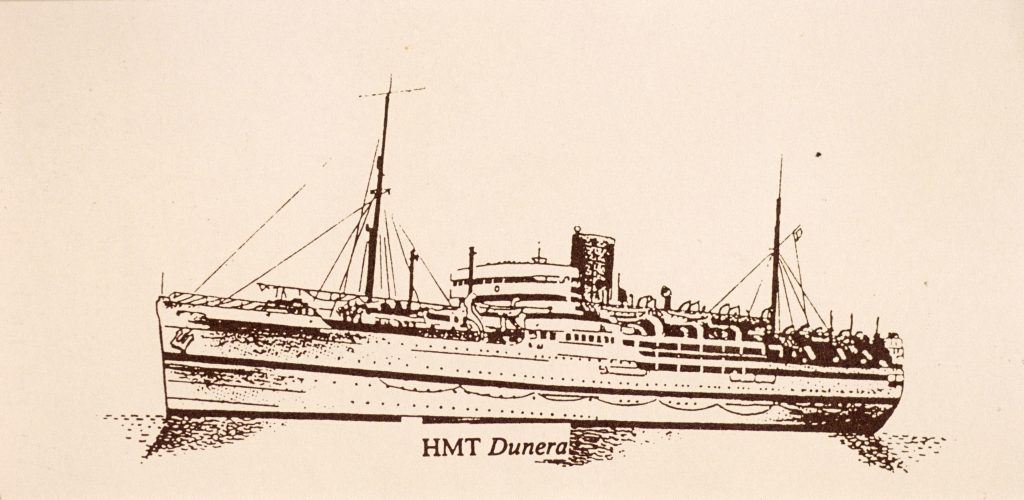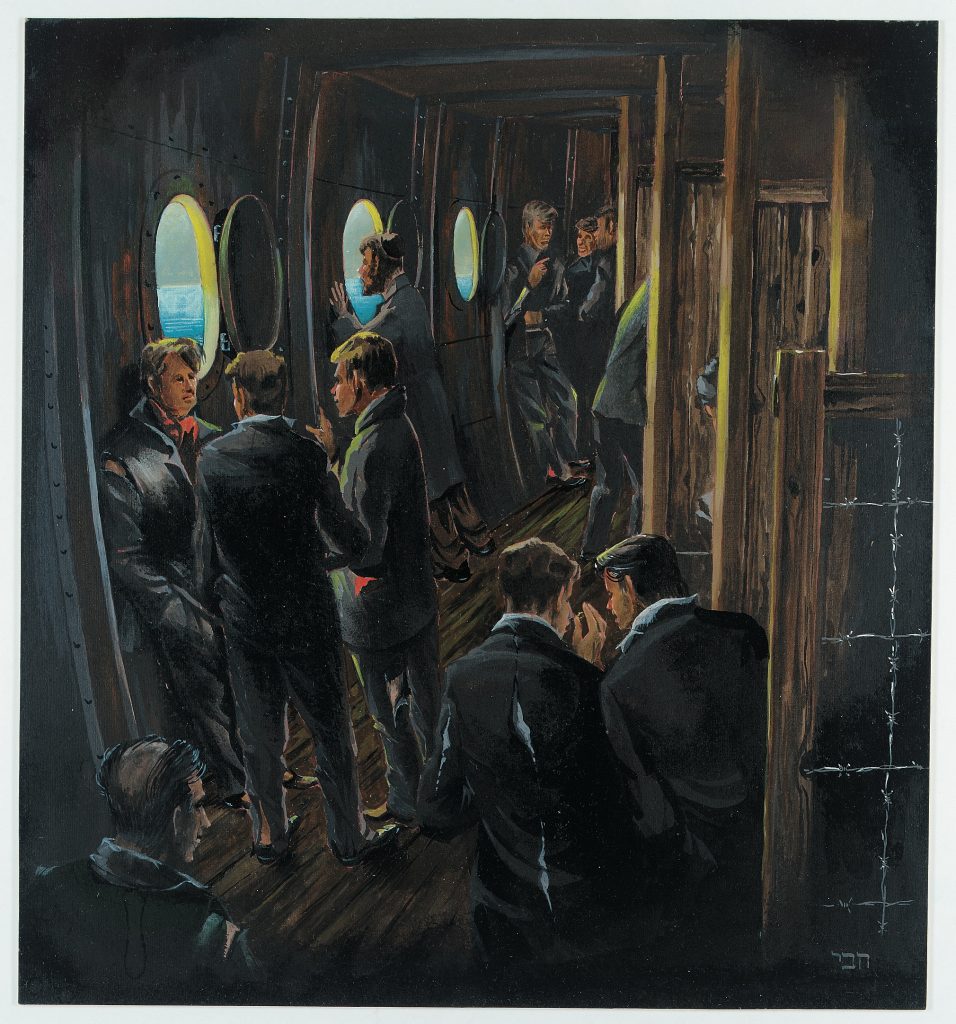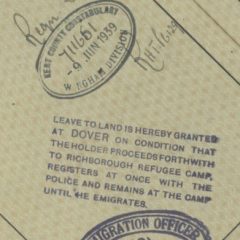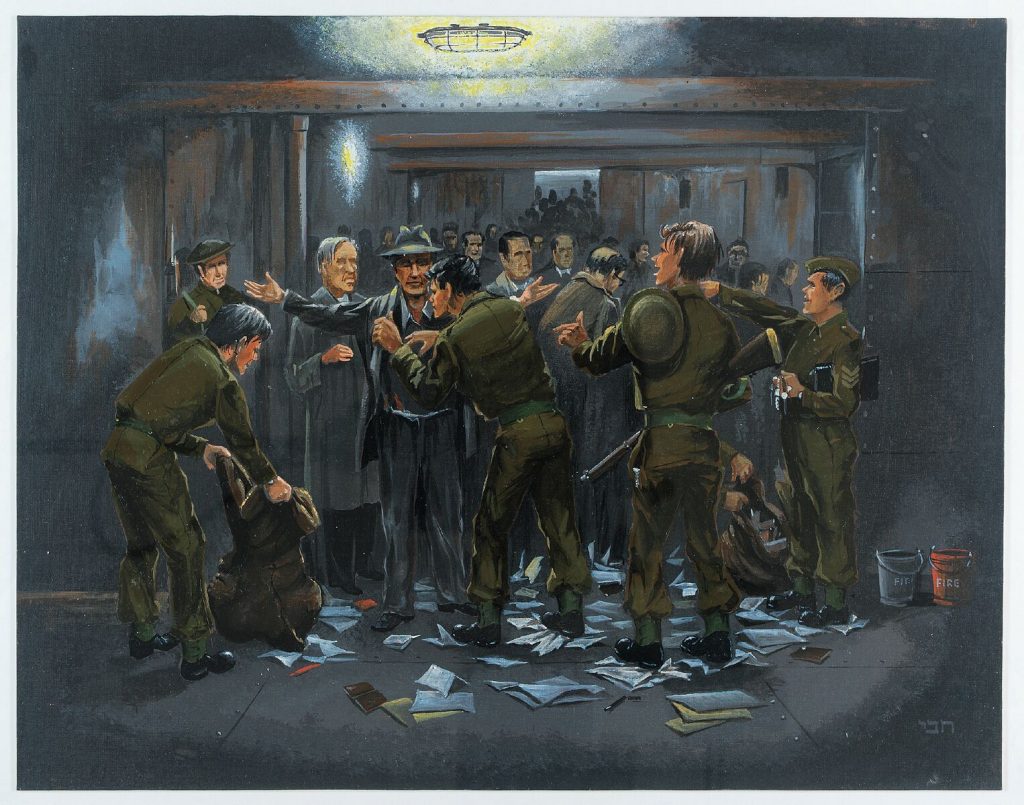In September 1939, when Britain declared war on Germany, alien tribunals were established to ascertain which Germans living in Britain were to be categorised as ‘friendly’ and which were to be deemed ‘enemy aliens’. Around 65,000 were initially categorised as ‘friendly’. When France fell, however, the government became nervous about invasion, and many Germans, Italians, and Austrians came under suspicion. The decision was made to intern in the UK or to deport (for internment) to Canada and Australia.
Around two hundred of these deportees had believed they had found refuge when they had arrived in 1939 at Kitchener camp in Kent. (Editor: this figure to be confirmed)
…………………………………………
Note: the Kitchener project has recently received some extremely useful notes from a researcher in Australia who has been a volunteer worker in the Dunera archives for many years.
The researcher wishes to remain anonymous; we have tracked the researcher’s additions to this project (mostly presented in the boxes below) with ‘AR’ – Australian Researcher.
…………………………………………
In July 1940, HMT Dunera sailed from Liverpool, UK, to Sydney, Australia.

With the kind permission of Allen Sternstein
On board were around 2,500 men (records vary) who were deemed to be ‘enemy aliens’; some were boys as young as sixteen: “Many of the internees were boys in the 16-19 years age group, one boy of 16 years being badly crippled through Jew baiting by Nazi boys in a country town in Germany. Others belonged to the Boy Scout movement in England” (Commonwealth of Australia, Prisoners of War, Information Bureau, 12 September 1940, National Archives of Australia, NAA: B3844, 1; barcode 411713). There was also a crew of around 14o on board the ship (Samuel Totten, Paul Robert Bartrop, Dictionary of Genocide: A-L, Greenwood Press, 2008).
The troop ship Dunera was built to hold around 1,600 people.
AR 2546 internees left England – 2542 disembarked in Australia. Escort guard was 7 officers and 309 other ranks. Source: Secretary Department of Navy Teleprinter message D. 89, 14 August 1940, to Secretary Prime Minister’s Department (NAA A1608, A20/1/3 PART 1). Cyril Pearl’s The Dunera Scandal (p. 22) also gives these figures. There is a slight variation in another source – 12 officers and 305 other ranks: the total only differs by one.
Among these passengers were 200 Italian fascists and 250 German Nazis; a few were Jewish or political refugees (AR). The vast majority – around two-thirds – were Jews who had fled the Third Reich territories. Some had been in Kitchener and 450 were survivors of the SS Arandora Star; some had been interned on the Isle of Man, Seaton and elsewhere.
AR There are 239 men who indicated they were “captured” at Kitchener on their Australian records. Some of those listed were on the Isle of Man prior to departure; the standard Australian records do not always specify the last camp in the UK. Among the 239 were three who arrived in England on a Kindertransport – date of arrival not known, so we are unable to say whether they had been sent to help set up the camp or for another reason. Also among the 239 were 24 men who were not enemy aliens - being Polish, Russian, or stateless. All bar three had lived in Germany or Austria for 16 years or more. There is a record in the Australian files in which Julian Layton states that the Richborough Committee looked at whether the men were refugees from National Socialism, rather than at nationality, when making decisions. This was in relation to the fact that Layton had to ask all non-enemy aliens who should not have been interned whether they wanted to return to the UK for release.
The Dunera arrived in Melbourne in September 1940: 545 disembarked here – all the Arandora Star survivors and 95 others (AR). Around five hundred deportees were transferred to Tatura internment camp. The others continued on to Sydney, from where they were transferred to internment in Hay.
…………………………………………
Conditions on board the Dunera were notoriously brutal. The men and boys were kept for most of the long voyage below decks in over-crowded conditions without even enough hammocks for all to sleep in.

With the kind permission of Allen Sternstein
According to many witness reports, guards assaulted the prisoners, for example, breaking glass bottles on the decks, which the men were then forced to run across, barefoot.
Punishments were extreme for minor offences, including two instances when men were bound with chains and put in the ship’s gaol for insubordination.
The men were given meagre food rations and insufficient water, especially for the climate in which they sailed. Much of the food was rancid; on one occasion the water ran out.
Sickness, diarrhoea, and dysentery were rife under such conditions, but the sick were retained below decks with the healthy, with the result that the sickness spread.
Because the men’s luggage was not made available to them, there were no changes of clothes: there was almost no soap or washing facilities, and the inadequate numbers of makeshift latrines soon flooded. There is a report of a man attempting to access the latrines at night, who was bayonetted in the stomach and hospitalised for the remainder of the voyage.
I haven’t been able to find the numbers yet, but have seen reports of deaths from heart attacks, for example, and one of our Kitchener descendants has documented a suicide during the voyage.
There was a group of Orthodox Jews on board who were only able to eat kosher food; they suffered particularly badly. One witness recounted, “It was a miracle they survived the entire voyage on prayer and cheddar cheese” (Professor Hugo Wolfson, National Archives of Australia, NNA: B3844, 1; barcode 411713).
Fighting broke out from time to time among the starving men – one died fighting for a small piece of fruit: “I consider the treatment metered out to these internees on the voyage was very unsatisfactory. The Medical Officer, Lt. Brooks, was continually at variance with the other officers in regard to the treatment of old men and the sick” (Commonwealth of Australia, Prisoners of War, Information Bureau, 12 September 1940, National Archives of Australia, NAA: B3844, 1; barcode 411713).
The men’s luggage was repeatedly ransacked, bayonetted open by the British soldiers guarding the detainees and prisoners. Valuables were stolen in a series of raids and many of the remaining items were thrown overboard: “It was reported to me just prior to leaving Sydney that the internees had arrived at Hay … The condition of this baggage was far from satisfactory. It was reported to me that the loading at Liverpool took place in the rain with the result that on disembarkation, a large quantity was found to be musty and damp. I have to report that during the journey this baggage was badly damaged by the escort. The O/c troops ordered the baggage to be opened and any clothing and food to be distributed amongst the internees, it is quite possible that other articles have been removed at the same time. This may form the basis for complaint by the internees; another complaint will be the damaged state of the baggage, in many cases locks were forced open, and the sides out … The actual tonnage of bags given to me by the O/c troops at Fremantle, was far below the actual tonnage on board … With regard to money that was alleged to be taken from internees and held on their behalf, the DFO Eastern Command made provision to collect many thousands of pounds, and was surprised when the O/c troops informed him that he did not hold any money belonging to internees” (Commonwealth of Australia, Prisoners of War, Information Bureau, 12 September 1940, National Archives of Australia, NAA: B3844, 1; barcode 411713).

With the kind permission of Allen Sternstein
The men were to be disembarked at Sydney and Melbourne. One man disguised himself as a Sergeant Major and crawled through a porthole on to the wharf in an effort to escape. He was discovered and arrested and placed in the ship’s cells: “the treatment metered out to this internee was contrary to Brtish justice and fair play, he was deprived of blankets and was brutally assaulted in the cells by a member of the escort, the damage inflicted being so severe that it was fortunate that the man did not succumb to his injuries. An inquiry was held … but I have no knowledge that any disciplinary action was taken. I have to report the death of one German internee between Melbourne and Sydney, this man died as a result of a blow administered by another internee” (Commonwealth of Australia, Prisoners of War, Information Bureau, 12 September 1940, National Archives of Australia, NAA: B3844, 1; barcode 411713).
…………………………………………
When reports soon began to circulate of the brutal conditions in which so many were transported overseas, the Home Office sent Major Julian Layton (who had been instrumental in the establishment of Kitchener camp), to assist. Charges were brought against some of the Dunera guards, and compensation payments were allocated, although many claim to have received little in the end.
AR The men were offered repatriation back to the UK, but by this stage both the initial journey and U-boat attacks put many off setting sail again. Some of the Dunera men went on to join the Pioneer Corps, and overall, around 900 decided to stay in Australia. A substantial number served in Australia's armed forces, notably in the specially formed Eighth Employment Company. At the end of the war, this service meant that they qualified for permanent residency status in Australia, where many remained. Not all of those sent to Australia remained here for the duration of the war. On VE Day their location (nominal location of those serving in military) was as follows:
| Country | German & Austrians | Non-enemy alien | Total |
| Australia | 125 | 11 | 136 |
| UK | 39 | 6 | 45 |
| Palestine | 41 | 5 | 46 |
| USA | 1 | 2 | 3 |
| Shanghai | 1 | 1 | |
| Died | 8 | 8 | |
| Total | 214 | 24 | 239 |
AR Of those still in Australia, only 11 out of 125 and one of the 11 non-enemy aliens were still interned on VE Day. All were transferred back to the UK in July 1945. Six of those who died were en route to the UK on the Abosso when it was sunk. One was still interned when he died, while the other had been released.
According to a long-term researcher into the voyage of HMT Dunera and Australian internment, the Kitchener men who were deported were put in Hay Camp 8 first, until Camp 7 was finished: then, all orthodox Jews, plus all the Kitchener group went into Camp 7.
There are some resources in the UK National Archives at Kew – catalogued online: with many thanks to researchers in the field for finding these for me.
http://discovery.nationalarchives.gov.uk/details/r/C1232608
http://discovery.nationalarchives.gov.uk/details/r/C2455081
http://discovery.nationalarchives.gov.uk/details/r/C2455067
http://discovery.nationalarchives.gov.uk/details/r/C2455128
http://discovery.nationalarchives.gov.uk/details/r/C2455082
http://discovery.nationalarchives.gov.uk/details/r/C3505097
http://discovery.nationalarchives.gov.uk/details/r/61f1ed2d-21ec-43be-9908-1aeb91862e5e
http://discovery.nationalarchives.gov.uk/details/r/C1232605
http://discovery.nationalarchives.gov.uk/details/r/C1941205
http://discovery.nationalarchives.gov.uk/details/r/C2454891
http://discovery.nationalarchives.gov.uk/details/r/C2455130
http://discovery.nationalarchives.gov.uk/details/r/C2455125
http://discovery.nationalarchives.gov.uk/details/r/02e88224-0161-4844-b4f3-75483b683148
http://discovery.nationalarchives.gov.uk/details/r/C2454869
http://discovery.nationalarchives.gov.uk/details/r/N14444691
http://discovery.nationalarchives.gov.uk/details/r/04b78c39-0851-40c4-b9be-50bc1c5a8a80
http://discovery.nationalarchives.gov.uk/details/r/7d1feaa6-2718-4776-9fcf-088b247159e1

